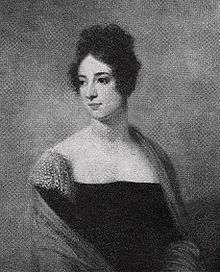Charlotta Skjöldebrand

Charlotta Letitia Skjöldebrand nèe Ennes (29 June 1791-17 April 1866), was a Swedish court official. She served as överhovmästarinna (Senior lady-in-waiting) to the crown princess, queen and queen dowager of Sweden, Josephine of Leuchtenberg, from 1835 to 1866.
Life
Charlotta Skjöldebrand was the daughter of Per Ennes and Elisabet Margareta Brändström. She married count Anders Fredrik Skjöldebrand in 1811, and became the mother of Eric Bogislaus Skjöldebrand.
In 1836, she was appointed to succeed Elisabet Charlotta Piper as senior lady-in-waiting to the crown princess Josephine: she kept her office after Josephine's elevation to queen in 1844, and widowhood in 1859.
Upon the succession of Oscar I of Sweden in 1844, a number of reforms where introduced to subdue "the most spectacular pomp" and provocative grandeur of court life, and several courtly ceremonies, customs and rituals where abolished.[1] Additionally, while the king allowed his mother the queen dowager to keep a full queen's household of the old standards and the use of the queen's apartments, most offices of both the king's and queen's household was left vacant for political reasons, and Charlotta Skjöldebrand was to introduce the reforms at a queen's court where the posts of statsfru (married ladies-in-waiting) was left vacant, leaving her without a deputy, and with only hovfröken (maids-of-honor) to supervise.[2]
Emil Key described her in 1864–65:
- "One of these sons-in-law where count August Skiöldebrand. He was the son of the state secretary etc. A. F. Skiöldebrand. He has been brought to life to our epoch through the memoirs of Malla Silfverstolpe, as has his wife Laetitia Ennes. I saw her often during the winter of 1864—65, when I was basically at boarding house at the Åhlins, but spent my weekends and Sundays i the pleasant home of my aunt Ingeborg and uncle, the governor's residence at the royal palace. The elder countess Skiöldebrand's excellently beautiful youth portrait by Breda was displayed on the wall, but she was not more beautiful there than in the silvery haired old woman. Formerly the senior lady-in-waiting, she had funny court stories to tell and did not deny herself to spice them with many a charmingly performed expletive."[3]
Charlotta Skjöldebrand was also active as a non-professional painter. [4]
References
- ↑ Rundquist, Angela, Blått blod och liljevita händer: en etnologisk studie av aristokratiska kvinnor 1850-1900, Carlsson, Diss. Stockholm : Univ.,Stockholm, 1989
- ↑ "Min gud tocket hov! Det svenska hovet från Napoleon till Louis Philippe" in Ingvar von Malmborg (ed) Familjen Bernadotte - kungligheter och människor. Stockholm, 2010
- ↑ Minnen av och om Emil Key / III
- ↑ Svenskt konstnärslexikon del V, sid 193, Allhems Förlag, Malmö. Libris 8390293
| Court offices | ||
|---|---|---|
| Preceded by Vilhelmina Gyldenstolpe |
Överhovmästarinna to the Queen of Sweden 1844–1859 |
Succeeded by Stefanie Hamilton |